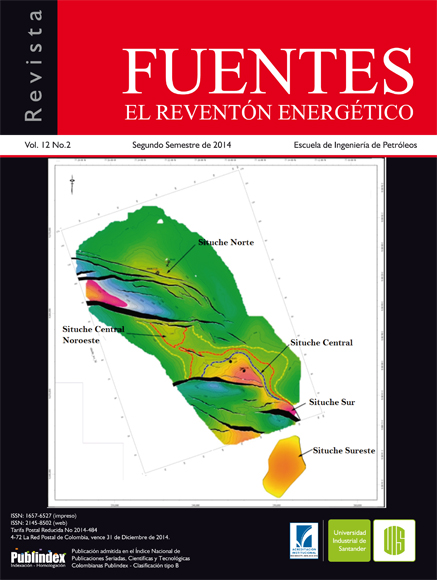Publicado 2015-06-05
Cómo citar
Resumen
RESUMEN
La determinación de la porosidad es una labor fundamental en el laboratorio de análisis petrofísicos, ya que de esta propiedad depende en gran parte la calidad del medio poroso, su almacenamiento (porosidad absoluta) y su productividad (porosidad efectiva). Para determinar la porosidad efectiva de una muestra prueba de saturación de fluidos. Esta prueba consiste en secar completamente una muestra, y saturarla de salmuera durante 12 a 18 horas, y la comparación de los pesos de la muestra antes y después de la saturación permitirá calcular la porosidad de esta. Este tiempo de saturación asegura que la totalidad de los poros son saturados de salmuera. Sin embargo, este proceso puede ser realizado de una manera más eficiente.
Este trabajo propone una metodología de saturación de solo 2 horas, la cual puede ser ajustada al
tiempo normal de la prueba mediante una correlación propuesta. Esta correlación fue construida
mediante la medición de la porosidad con ambas metodologías para unas muestras de la cuenca de los Llanos Orientales y fue calculada mediante la herramienta STATGRAPHICS CENTURION XVI. Los
resultados indican que la correlación puede estimar correctamente el valor de la porosidad absoluta con un intervalo de confianza del 99%, reduciendo el tiempo de la prueba en aproximadamente una novena parte de su tiempo original. Se requieren trabajos posteriores que permitan corroborar la validez de esta correlación con muestras de diferentes litologías.
Palabras clave: Análisis Petrofísicos, Porosidad, Saturación, Diseño Experimental.
OPTIMIZATION OF THE METHODOLOGY FOR POROSITY MEASUREMENT BY FLUID SATURATION PROCESS
ABSTRACT
Porosity determination is a major labor in a petrophysical analysis laboratory, since the reservoir
quality, the storage capacity (absolute porosity) and the productivity (effective porosity) depends (in
great part) from this property. There are many proceedings to determine the effective porosity of a rock core sample in the API RP-40, one of them is the Fluid Saturation test. This test consist in the previous drying of a core sample, and then a complete brine saturation during 12 to 18 hours. The weight difference of the sample after and before the saturation process allows to calculate their effective porosity.
This saturation time assures that all the porous spaces are filled with brine. However, this process could be more time-efficient.
This work propose a 2-hours saturation methodology, which result can be adjusted to the proper time
by a proposed correlation. This correlation were constructed by the porosity saturation measurement
for three core samples of the Llanos Orientales Sedimentary Basin with both methodologies, and then
calculated using STATGRAPHICS CENTURION XVI.
The results indicate a successful estimation of the absolute porosity using the proposed correlation
with a confidence interval of 98%, reducing the test time in approximately a ninth of the original time.
Further works are required in order to check the validity of the correlation with different lithology.
Keywords: Petrophysics, Porosity, Saturation, Experimental Design.
